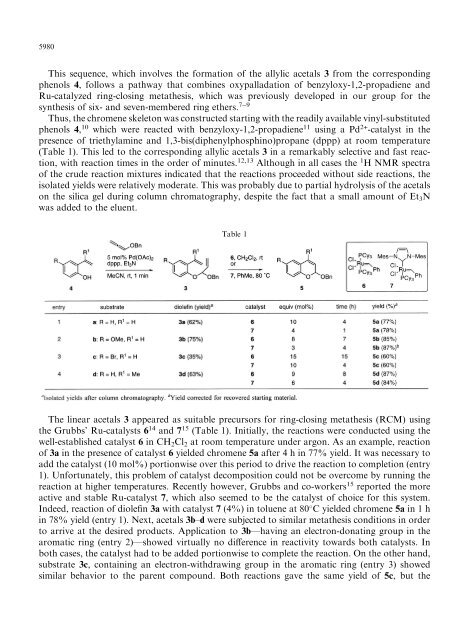Synthesis of 2-substituted chromenes via ring-closing metathesis ...
Synthesis of 2-substituted chromenes via ring-closing metathesis ...
Synthesis of 2-substituted chromenes via ring-closing metathesis ...
- No tags were found...
You also want an ePaper? Increase the reach of your titles
YUMPU automatically turns print PDFs into web optimized ePapers that Google loves.
5980<br />
This sequence, which involves the formation <strong>of</strong> the allylic acetals 3 from the corresponding<br />
phenols 4, follows a pathway that combines oxypalladation <strong>of</strong> benzyloxy-1,2-propadiene and<br />
Ru-catalyzed <strong>ring</strong>-<strong>closing</strong> <strong>metathesis</strong>, which was previously developed in our group for the<br />
synthesis <strong>of</strong> six- and seven-membered <strong>ring</strong> ethers. 79<br />
Thus, the chromene skeleton was constructed starting with the readily available vinyl-<strong>substituted</strong><br />
phenols 4, 10 which were reacted with benzyloxy-1,2-propadiene 11 using a Pd 2+ -catalyst in the<br />
presence <strong>of</strong> triethylamine and 1,3-bis(diphenylphosphino)propane (dppp) at room temperature<br />
(Table 1). This led to the corresponding allylic acetals 3 in a remarkably selective and fast reaction,<br />
with reaction times in the order <strong>of</strong> minutes. 12,13 Although in all cases the 1 H NMR spectra<br />
<strong>of</strong> the crude reaction mixtures indicated that the reactions proceeded without side reactions, the<br />
isolated yields were relatively moderate. This was probably due to partial hydrolysis <strong>of</strong> the acetals<br />
on the silica gel du<strong>ring</strong> column chromatography, despite the fact that a small amount <strong>of</strong> Et 3 N<br />
was added to the eluent.<br />
Table 1<br />
The linear acetals 3 appeared as suitable precursors for <strong>ring</strong>-<strong>closing</strong> <strong>metathesis</strong> (RCM) using<br />
the Grubbs' Ru-catalysts 6 14 and 7 15 (Table 1). Initially, the reactions were conducted using the<br />
well-established catalyst 6 in CH 2 Cl 2 at room temperature under argon. As an example, reaction<br />
<strong>of</strong> 3a in the presence <strong>of</strong> catalyst 6 yielded chromene 5a after 4 h in 77% yield. It was necessary to<br />
add the catalyst (10 mol%) portionwise over this period to drive the reaction to completion (entry<br />
1). Unfortunately, this problem <strong>of</strong> catalyst decomposition could not be overcome by running the<br />
reaction at higher temperatures. Recently however, Grubbs and co-workers 15 reported the more<br />
active and stable Ru-catalyst 7, which also seemed to be the catalyst <strong>of</strong> choice for this system.<br />
Indeed, reaction <strong>of</strong> diole®n 3a with catalyst 7 (4%) in toluene at 80 C yielded chromene 5a in 1 h<br />
in 78% yield (entry 1). Next, acetals 3b±d were subjected to similar <strong>metathesis</strong> conditions in order<br />
to arrive at the desired products. Application to 3bÐhaving an electron-donating group in the<br />
aromatic <strong>ring</strong> (entry 2)Ðshowed virtually no di€erence in reactivity towards both catalysts. In<br />
both cases, the catalyst had to be added portionwise to complete the reaction. On the other hand,<br />
substrate 3c, containing an electron-withdrawing group in the aromatic <strong>ring</strong> (entry 3) showed<br />
similar behavior to the parent compound. Both reactions gave the same yield <strong>of</strong> 5c, but the
















